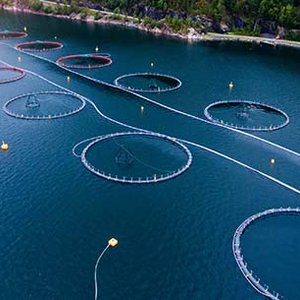Researchers support the future of eel
The reproduction of eels in captivity has become an important research focus due to the severe decline of the natural stocks. Leading scientists from European research institutes and the aquaculture industry are determined to reproduce the European eel in captivity. The result is a €5 mill research project: PRO-EEL, coordinated by DTU and supported financially by the European Commission.
Many fish species do not reproduce in captivity and eels are among them. In the wild, the European eel migrate to the Sargasso Sea to spawn. They do not reproduce in our waters due to a hormonal inhibition of maturation. In the PRO-EEL project the eels therefore receive hormonal treatment to develop gametes and fertilization is made in vitro.
The objectives of the PRO-EEL project are to expand the current knowledge on European eel reproduction and develop methods for successful maturation and production of offspring. This includes selecting suitable broodstocks, improving the quality of eggs and sperm, and fertilization methods and culture conditions conducive to the production of viable eggs and larvae. A particular challenge will be to find suitable feed and establish feeding cultures of larvae.
The long term perspective of this research – and an indicated goal of the European Commission – is to establish a self-sustained aquaculture of eels in Europe.
Eels are challenging
“The primary bottleneck in a controlled reproduction of eels concerns deficiencies in knowledge about their reproductive physiology and methods applied to induce and finalize gamete development,” says the coordinator of the project, Jonna Tomkiewicz from DTU Aqua.
Researchers will apply gene technology and molecular methods to establish that knowledge base that is crucial to the successful reproduction of the European eel. These new tools will help obtain a regular and predictable production of viable eggs and larvae from broodstock eels offered enhanced diets.
Further challenges include the identification of suitable larval rearing conditions and initial feed for the larvae. A particular issue is the step where larvae need to start feeding on their own and the diet is crucial for their healthy development and growth.
The establishment of first feeding and feeding cultures of larvae will be major breakthroughs in European eel research and an important and promising step towards a self-sustained aquaculture of the European eel. However, the eel larval phase is very long – lasting one year or more – and the production of eels will need further research on suitable feed and culture techniques to assure their transformation from larvae to glass eels.
Promising results in reproduction
The PRO-EEL project builds on the cutting edge results of the consortium – including the recent results of a series of DTU coordinated research projects that succeeded in producing larvae of the European eel that survived up to 21 days. These larvae accomplished the first so-called yolk sac stage and entered the period where they require feeding.
These results provide the basis for the present PRO-EEL research team of experts that complement each other within disciplines relating to fish reproduction and aquaculture.
Recently, researchers in Japan succeeded in producing offspring from captive-bred Japanese eel and thereby successfully completing the life cycle of eel in captivity. The Japanese eel is a closely related species to the European eel, and these promising results bode well for the chances of success for the PRO-EEL project.
Towards a self-sustained aquaculture of eel
The PRO-EEL project will contribute to a shift from capture-based aquaculture towards a self-sustained aquaculture. This involves replacing the use of wild glass eels as stocking material for aquaculture with fry produced under controlled conditions. The PRO-EEL technology development and the increasing knowledge about the reproduction of the European eel back up management initiatives to help preserving the species.
New findings on the early life of eel and the larval drift towards Europe
The oceanic life of eel is still a mystery. New findings from the Danish Galathea 3 Expedition to the Sargasso Sea now shed light on the conditions for larval growth and feeding and point to an alternative route for larval drift towards Europe
As both European and American eel populations are in a drastic decline, there is an urgent need for a better understanding of the early oceanic phase of their life cycle.
Two new findings are now being published from a research project which collected data on the eel’s spawning sites in the Sargasso Sea on the Danish Galathea 3 Expedition in 2007.
Climate change may influence life cycle completion of eel
Scientific results published in Proceedings of the Royal Society show the importance of including the climatic influence on oceanic processes when assessing the conditions for the early life of eel and the background of a declining recruitment to the eel populations.
"Our studies in the Sargasso Sea demonstrate a significant relationship between the physical and biological conditions in the area. A front established where warm tropical waters meet colder North Atlantic water has a key role in the larval life of eel" says Senior Scientist Peter Munk from DTU Aqua.
The front retains eel larvae within a zone of enhanced feeding conditions and influences their drift towards the continent.
European eel larvae are generally believed to initially follow a westerly drift route from the spawning site and subsequently drift with the Gulf Stream. But the study’s demonstration of a strong linkage between larval distributions and the fronts in the area suggests another possibility.
The front between the warm and cold waters leads to a current which, contrary to the predominant currents in the area, is directed eastward, and the distribution of larvae indicates that they could use this "subtropical counter current" as a shorter and faster route towards Europe.
These oceanic processes are affected by climate change, and the study shows the importance of including them in the understanding of the life cycle completion of eel and the fluctuations in stock sizes.
Insight into the diet of eel larvae
Other research finding from the Galathea 3 Expedition has just been published in Biology Letters and describes the diet of eel larvae. The scientists brought home very small eel larvae (5-25 mm) from the Sargasso Sea to find out what they actually eat.
It has been assumed that the eel’s long journey to the Sargasso Sea was linked to the feeding opportunities in the area for the newly hatched eel larvae. So far, knowledge about what and if eel larvae eat has been sparse, as only very few larvae have been found with identifiable prey items in the gut.
The eel larvae from the Galathea 3 Expedition have now been analysed using DNA barcoding, which makes it possible to identify the various plankton organisms found in the otherwise unidentifiable gut contents.
The findings show that even the smallest eel larvae eat remarkably diverse marine organisms. Gelatinous zooplankton, in particular, e.g. small jellyfish, play an important role in their diet. The study suggests that the frontal zone in the Sargasso Sea provides ample feeding opportunities for the eel larvae.
The findings relating to larval diet may be very useful in connection with artificial reproduction and rearing of the European eel, where one of the major questions is what to feed to the eel larvae.
The studies of larval diet were conducted by Associate Professor Lasse Riemann from the University of Copenhagen in collaboration with, amongst others, scientists from DTU Aqua.
The scientific article in Biology Letters: Lasse Riemann et al.: Qualitative assessment of the diet of European eel larvae in the Sargasso Sea resolved by DNA barcoding: click here.










